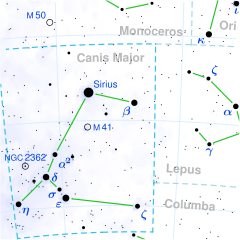Theta Canis Majoris
| Observation data EpochJ2000.0EquinoxJ2000.0(ICRS) | |
|---|---|
| Constellation | Canis Major |
| Right ascension | 06h54m11.399s[1] |
| Declination | −12° 02′ 19.061″[1] |
| Apparent magnitude(V) | 4.08[2] |
| Characteristics | |
| Evolutionary stage | Red giant |
| Spectral type | K4 III[2] |
| U−Bcolor index | +1.69[3] |
| B−Vcolor index | +1.43[3] |
| Astrometry | |
| Radial velocity(Rv) | +96.2±0.1[4]km/s |
| Proper motion(μ) | RA:−136.454mas/yr[1] Dec.:−14.322mas/yr[1] |
| Parallax(π) | 12.0676 ± 0.62mas[1] |
| Distance | 270 ± 10ly (83 ± 4pc)[1] |
| Absolute magnitude(MV) | −0.36±0.15[5] |
| Details | |
| Mass | 1.5[6]or 0.89 – 0.94[7]M☉ |
| Radius | 33.01±0.75[8]R☉ |
| Luminosity | 304.9±7[8]L☉ |
| Surface gravity(logg) | 1.52[6]cgs |
| Temperature | 4196±43[8]K |
| Metallicity[Fe/H] | −0.34±0.09[6]dex |
| Rotational velocity(vsini) | 2.72±0.40[4]km/s |
| Age | 7.94 or 8.71[7]Gyr |
| Other designations | |
| Database references | |
| SIMBAD | data |
Theta Canis Majoris(θ Canis Majoris) is a solitary,[10]orange-huedstarnear the northern edge[11]of theconstellationCanis Major,forming the nose of the "dog".[12]The star is visible to the naked eye with anapparent visual magnitudeof 4.08.[2]Based upon an annualparallax shiftof 12.07masas seen from Earth,[1]it is located about 270light yearsfrom the Sun. The star is moving away from Earth with aradial velocityof +96.2 km/s.[4]
This is an old,evolvedK-typegiant starwith astellar classificationof K4 III.[2]Its mass is uncertain, and may be either 1.5[6]or aroud 0.9 times theSun's mass.It is either 7.9 or 8.7 billion years old (assuming 0.94 – 0.89M☉as the mass)[7]and has expanded to 33 times the Sun's size.[8]The star is radiating 305 times theSun's luminosityfrom itsphotosphereat aneffective temperatureof 4,200 K.[8]
References[edit]
- ^abcdefVallenari, A.; et al. (Gaia collaboration) (2023)."GaiaData Release 3. Summary of the content and survey properties ".Astronomy and Astrophysics.674:A1.arXiv:2208.00211.Bibcode:2023A&A...674A...1G.doi:10.1051/0004-6361/202243940.S2CID244398875. Gaia DR3 record for this sourceatVizieR.
- ^abcdSetiawan, J.; et al. (July 2004), "Precise radial velocity measurements of G and K giants. Multiple systems and variability trend along the Red Giant Branch",Astronomy and Astrophysics,421:241–254,Bibcode:2004A&A...421..241S,doi:10.1051/0004-6361:20041042-1.
- ^abJohnson, H. L.; et al. (1966), "UBVRIJKL photometry of the bright stars",Communications of the Lunar and Planetary Laboratory,4(99): 99,Bibcode:1966CoLPL...4...99J.
- ^abcJofré, E.; et al. (2015), "Stellar parameters and chemical abundances of 223 evolved stars with and without planets",Astronomy & Astrophysics,574:A50,arXiv:1410.6422,Bibcode:2015A&A...574A..50J,doi:10.1051/0004-6361/201424474,S2CID53666931.
- ^da Silva, L.; et al. (November 2006), "Basic physical parameters of a selected sample of evolved stars",Astronomy and Astrophysics,458(2): 609–623,arXiv:astro-ph/0608160,Bibcode:2006A&A...458..609D,doi:10.1051/0004-6361:20065105,S2CID9341088.
- ^abcdAyres, Thomas (2023-05-01)."In the Trenches of the Solar-Stellar Connection. VII. Wilson-Bappu 2022".The Astrophysical Journal Supplement Series.266(1): 6.Bibcode:2023ApJS..266....6A.doi:10.3847/1538-4365/acb535.ISSN0067-0049.Theta Canis Majoris' database entryatVizieR.
- ^abcStock, Stephan; Reffert, Sabine; Quirrenbach, Andreas (2018-08-01)."Precise radial velocities of giant stars. X. Bayesian stellar parameters and evolutionary stages for 372 giant stars from the Lick planet search".Astronomy and Astrophysics.616:A33.arXiv:1805.04094.Bibcode:2018A&A...616A..33S.doi:10.1051/0004-6361/201833111.ISSN0004-6361.Theta Canis Majoris' database entryatVizieR.
- ^abcdeBaines, Ellyn K.; Clark, James H., III; Schmitt, Henrique R.; Stone, Jordan M.; von Braun, Kaspar (2023-12-01), "33 New Stellar Angular Diameters from the NPOI, and Nearly 180 NPOI Diameters as an Ensemble",The Astronomical Journal,166(6): 268,Bibcode:2023AJ....166..268B,doi:10.3847/1538-3881/ad08be,ISSN0004-6256
{{citation}}:CS1 maint: multiple names: authors list (link) - ^"tet CMa".SIMBAD.Centre de données astronomiques de Strasbourg.Retrieved2017-09-08.
{{cite web}}:CS1 maint: postscript (link) - ^Eggleton, P. P.; Tokovinin, A. A. (September 2008), "A catalogue of multiplicity among bright stellar systems",Monthly Notices of the Royal Astronomical Society,389(2): 869–879,arXiv:0806.2878,Bibcode:2008MNRAS.389..869E,doi:10.1111/j.1365-2966.2008.13596.x,S2CID14878976.
- ^Kaler, James N. (March 8, 2013),"Theta and Lambda Canis Majoris",STARS,University of Illinois,retrieved2017-09-08.
- ^Crossen, Craig; Rhemann, Gerald (2012),Sky Vistas: Astronomy for Binoculars and Richest-Field Telescopes,Springer Science & Business Media, p. 112,ISBN978-3709106266.

